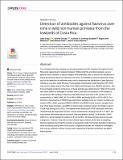| dc.contributor.author | Dolz, Gaby | |
| dc.contributor.author | Chaves, Andrea | |
| dc.contributor.author | Gutiérrez-Espeleta, Gustavo A. | |
| dc.contributor.author | Ortiz-Malavasi, Edgar | |
| dc.contributor.author | BERNAL VALLE, SOFÍA | |
| dc.contributor.author | Herrero, Marco Vinicio | |
| dc.date.accessioned | 2020-06-05T23:16:54Z | |
| dc.date.available | 2020-06-05T23:16:54Z | |
| dc.date.issued | 2019-07-05 | |
| dc.identifier.uri | http://hdl.handle.net/11056/17518 | |
| dc.description | Proyecto: "Estudios epidemiológicos (Malaria, Dengue, Virus del Oeste del Nilo, Encefalitis Equina Venezolana), genéticos, etológicos, poblacionales y de hábitat en monos de Costa Rica" | es_ES |
| dc.description.abstract | Two-hundred-nine free ranging non-human primates from 31 locations throughout Costa
Rica were captured and released between 1993 and 2012, and blood samples, sera or
plasma were collected, to detect antigens and antibodies, and so assess the distribution of
active and passive flavivirus infections over time. A competitive enzyme-linked immunoassay
for the detection of antibodies was used to determine the distribution of past flavivirus
infections over time, while Reverse Transcriptase Polymerase Chain Reaction (RT-PCR)
was used to detect active West Nile Virus (WNV) and Dengue virus (DENV) infections. The
first serological evidence of flavivirus in these animals was determined in 1993, at the same
time when DENV re-emerged in humans from Costa Rica. An increase in the number of
seropositive wild monkeys to flavivirus was determined over time in the country (11.3%
seropositivity in 1993–1996, 20.7% in 2001–2008, and finally 52.9% in 2010–2012). Furthermore,
the presence of DENV2 was detected in samples from four howler monkeys collected
in 2001–2002, whereas DENV2, DENV3, and DENV4 were found in samples from
four white-faced monkeys, and WNV in three howler monkeys living in the Pacific coast of
Costa Rica during 2010–2012. The habitat where the positive PCR individuals lived were
characterized as fragmented forests, having temperatures ranging from 26˚C to 28˚C, altitudes
below 250 meters above sea level, high precipitation during 7 to 9 months (1500–
4000 mm), and a marked dry season of 3 to 5 months. All these animals were living near
mangroves; however, they did not show clinical signs of illness at the time of sampling.
Results obtained show that the number of seropositive wild non-human primates to flavivirus
were increasing during time in the country, longitudinal studies are needed to investigate
their role as sentinels of these viruses and to determine if flavivirus infections can affect
these species. | es_ES |
| dc.description.abstract | Se capturaron y liberaron doscientos nueve primates no humanos en libertad de 31 ubicaciones en todo Costa Rica entre 1993 y 2012, y se recolectaron muestras de sangre, suero o plasma, para detectar antígenos y anticuerpos, y así evaluar la distribución de activos y Infecciones pasivas de flavivirus a lo largo del tiempo. Se usó un inmunoensayo competitivo ligado a enzimas para la detección de anticuerpos para determinar la distribución de infecciones pasadas por flavivirus a lo largo del tiempo, mientras que la Reacción en cadena de la polimerasa de transcriptasa inversa (RT-PCR) se usó para detectar el virus del Nilo activo (VNO) y el virus del dengue ( DENV) infecciones. La primera evidencia serológica de flavivirus en estos animales se determinó en 1993, al mismo tiempo que DENV resurgió en humanos de Costa Rica. A lo largo del tiempo, se determinó un aumento en el número de monos salvajes seropositivos a flavivirus en el país (11.3% de seropositividad en 1993–1996, 20.7% en 2001–2008, y finalmente 52.9% en 2010–2012). Además, se detectó la presencia de DENV2 en muestras de cuatro monos aulladores recolectados en 2001-2002, mientras que DENV2, DENV3 y DENV4 se encontraron en muestras de cuatro monos cariblancos y WNV en tres monos aulladores que vivían en la costa del Pacífico de Costa Rica durante 2010-2012. El hábitat donde vivían los individuos con PCR positiva se caracterizó por bosques fragmentados, con temperaturas que oscilaban entre 26 ° C y 28 ° C, altitudes por debajo de los 250 metros sobre el nivel del mar, altas precipitaciones durante 7 a 9 meses (1500– 4000 mm) y un estación seca marcada de 3 a 5 meses. Todos estos animales vivían cerca de los manglares; sin embargo, no mostraron signos clínicos de enfermedad al momento del muestreo. Los resultados obtenidos muestran que el número de primates seropositivos no humanos salvajes para flavivirus aumentaba durante el tiempo en el país, se necesitan estudios longitudinales para investigar su papel como centinelas de estos virus y determinar si las infecciones por flavivirus pueden afectar a estas especies. | es_ES |
| dc.description.sponsorship | FEES-CONARE | es_ES |
| dc.language.iso | eng | es_ES |
| dc.publisher | PLOS ONE | es_ES |
| dc.rights | Acceso abierto | es_ES |
| dc.rights.uri | http://creativecommons.org/licenses/by-nc-nd/4.0/ | * |
| dc.source | PLOS ONE pág. 1-12. July 5, 2019 | es_ES |
| dc.subject | PCR | es_ES |
| dc.subject | FLAVIVIRUS | es_ES |
| dc.subject | ANTICUERPOS | es_ES |
| dc.subject | COSTA RICA | es_ES |
| dc.subject | MONOS | es_ES |
| dc.subject | WILD MONKEYS | es_ES |
| dc.subject | ANTIBODIES | es_ES |
| dc.title | Detection of antibodies against flavivirus over time in wild non-human primates from the lowlands of Costa Rica | es_ES |
| dc.type | http://purl.org/coar/resource_type/c_6501 | es_ES |
| dc.description.procedence | Escuela de Medicina Veterinaria | es_ES |
| dc.identifier.doi | https://doi.org/10.1371/journal.pone.0219271 | |


